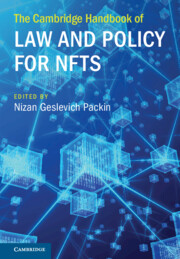Book contents
- The Cambridge Handbook of Law and Policy for NFTs
- The Cambridge Handbook of Law and Policy for NFTs
- Copyright page
- Dedication
- Contents
- Figures
- Tables
- Contributors
- Acknowledgments
- Part I Introduction and Background
- Part II Financial Regulation and Investor Protection
- Part III Capital Markets, Community, and Marketing
- Part IV Intellectual Property and Ownership Rights
- Part V Data Protection, Privacy, Cybersecurity, and NFTs
- 15 Fungibility, Information Flow, and Privacy
- 16 The Cybersecurity of NFTs and Digital Assets
- 17 NFTs within the Commercial Supply Chain
- Part VI Other Legal Issues with NFTs
- Part VII Conclusions and Future Directions
- Index
15 - Fungibility, Information Flow, and Privacy
from Part V - Data Protection, Privacy, Cybersecurity, and NFTs
Published online by Cambridge University Press: 02 November 2024
- The Cambridge Handbook of Law and Policy for NFTs
- The Cambridge Handbook of Law and Policy for NFTs
- Copyright page
- Dedication
- Contents
- Figures
- Tables
- Contributors
- Acknowledgments
- Part I Introduction and Background
- Part II Financial Regulation and Investor Protection
- Part III Capital Markets, Community, and Marketing
- Part IV Intellectual Property and Ownership Rights
- Part V Data Protection, Privacy, Cybersecurity, and NFTs
- 15 Fungibility, Information Flow, and Privacy
- 16 The Cybersecurity of NFTs and Digital Assets
- 17 NFTs within the Commercial Supply Chain
- Part VI Other Legal Issues with NFTs
- Part VII Conclusions and Future Directions
- Index
Summary
Non-fungible tokens (NFTs) introduce unique concerns related to the privacy of personal data. To create an NFT, users upload data to publicly accessible and searchable databases. This data can encompass information essential for the creation, transfer, and storage of the NFT, as well as personal details pertaining to the creator. Additionally, users might inadvertently engage with technology crafted to gather personal data. Traditional paradigms of privacy have not evolved in tandem with advancements in NFT and blockchain technology. To pinpoint where current privacy paradigms falter, this chapter delves into an introduction of NFTs, elucidating their foundational technical mechanisms and processes. Subsequently, the chapter juxtaposes current and historical privacy frameworks with NFTs, underscoring how these models may be either overly expansive or excessively restrictive for this emerging technology. This chapter suggests that Helen Nissenbaum’s concept of “contextual integrity” might offer the requisite flexibility to cater to the distinct attributes of NFTs. In conclusion, while there is a pronounced societal drive to safeguard citizen data and privacy, the overarching aim remains the enhancement of the collective good. Balancing this objective, governments should be afforded the latitude to equate society’s privacy interests with its imperative for transparency.
- Type
- Chapter
- Information
- The Cambridge Handbook of Law and Policy for NFTs , pp. 299 - 320Publisher: Cambridge University PressPrint publication year: 2024

